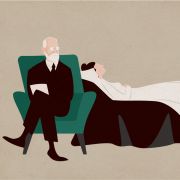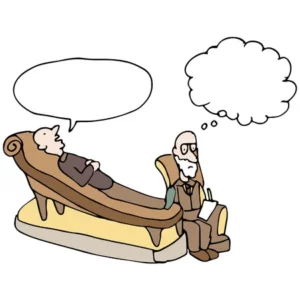Freudian therapy is a comprehensive approach to mental health that is based on the theories of Sigmund Freud. It is one of the oldest and most popular forms of therapy and can be used to treat a variety of mental health issues. In this blog post, we will discuss the history, theory, and application of Freudian therapy. We will also explore some of the pros and cons of this approach to mental health treatment.
Contents
Defining Freudian Therapy

Freudian therapy, also known as psychoanalysis, is a type of therapy that emphasizes the importance of the unconscious mind in shaping our behavior. Freud believed that our conscious minds are only aware of a small amount of the information that is processed by our brains. The rest of this information is stored in the unconscious mind, where it can influence our thoughts and behavior in ways that we are not aware of.
The history of Freudian therapy goes back to the late 1800s, when Freud began developing his theories about the mind. He first published his ideas in a book called The Interpretation of Dreams, which was followed by a number of other important works. Freud continued to refine his theories throughout his career, and they have had a major impact on the field of psychology.
Freudian therapy is based on the premise that our unconscious minds are full of hidden desires and impulses that can lead to psychological problems. By bringing these hidden desires to light, Freud believed that people could overcome their mental health issues.
Freudian therapy is a long-term process that usually takes place over several years. During therapy, patients work with their therapist to explore their unconscious thoughts and feelings. The goal of Freudian therapy is to help patients become aware of the unconscious thoughts and feelings that are influencing their behavior. Once these thoughts and feelings are brought into conscious awareness, patients can begin to work on changing them.
Types And Techniques
Freudian therapy has a wide range of techniques that can be used to treat different mental health issues. Some of the most common techniques include:
Psychoanalysis
Psychoanalysis is one of the most well-known types of Freudian therapy. It is a long-term process that usually takes place over several years. During therapy, patients work with their therapist to explore their unconscious thoughts and feelings. It involves free association, in which patients say whatever comes to mind without censorship. Patients may also use dream analysis and other such techniques to explore the unconscious mind. The aim of this technique is to help patients become aware of the unconscious thoughts and feelings that are influencing their behavior. Once these thoughts and feelings are brought into conscious awareness, patients can begin to work on changing them.
Free association

Free association is a technique that is used in Freudian therapy. It involves patients saying whatever comes to mind without censorship. This can help patients to explore their unconscious thoughts and feelings. This process of therapy involves the client’s talking about anything that comes to their mind regardless of how trivial it may seem. This helps in uncovering the hidden aspects of the client’s personality. Accessing these thoughts and ideas contributes to a better understanding of why the patient behaves in certain ways.
Dream analysis

Analysis of dreams is another technique that is used in Freudian therapy. Dreams are seen as a way of accessing the unconscious mind. They can provide insight into the thoughts and feelings that a person is not aware of. In dream analysis, patients work with their therapist to explore the symbolism and meaning of their dreams. This can help them to understand the unconscious thoughts and feelings that are influencing their behavior. There are various kinds of symbolism and their meanings which can be looked up in a dream dictionary. This interpretation will depend upon the patient’s situation and will vary from one individual to another.
Transference
Transference is a technique that occurs when patients transfer their feelings about someone from their past onto their therapist. This can be positive or negative. For example, a patient may see their therapist as a parent figure and transfer feelings of love and admiration onto them. Or, a patient may see their therapist as someone who has betrayed them and transfer feelings of anger and resentment onto them. Transference can help patients to understand the unconscious thoughts and feelings that are influencing their behavior. It is important to remember that transference can be positive or negative. It is up to the therapist to manage the transference and help the patient to understand it.
Countertransference

Countertransference is a technique that occurs when the therapist transfers their own feelings onto the patient. This can be positive or negative. For example, the therapist may feel empathy for the patient and transfer feelings of compassion onto them. Or, the therapist may feel anger towards the patient and transfer those feelings onto them. Countertransference can help therapists to understand their own unconscious thoughts and feelings. It can also help them to understand the transference that is occurring with the patient. The distinction between transference and countertransference makes the process of therapy more effective.
There are many different types of Freudian therapy, each with its own techniques. The goal of all these therapies is to help patients become aware of their unconscious thoughts and feelings so that they can begin to work on changing them. If you think Freudian therapy could be helpful for you, talk to your mental health professional about it. They can help you find a therapist who specializes in this type of therapy.
What Happens In A Session?
The first step in a session of Freudian therapy is to build rapport with the client. The therapist will try to establish a good relationship with the client so that they can feel comfortable talking about their thoughts and feelings.
The next step is to assess the patient’s symptoms. The therapist will ask the patient questions about their symptoms and how they are impacting their life. This information will help the therapist to understand the nature of the problem and develop a treatment plan.
After this, the therapist will begin to explore the unconscious thoughts and feelings that are causing the patient’s symptoms. This may involve techniques such as free association, dream analysis, or transference. The goal of these techniques is to help patients become aware of their unconscious thoughts and feelings so that they can begin to work on changing them.
Once you’ve started therapy, the therapist will work with you to explore your unconscious thoughts and feelings. This process can be difficult, but it can also be very rewarding. With time and patience, Freudian therapy can help you to understand yourself better and make lasting changes in your life.
Benefits

There are many benefits of Freudian therapy.
- One of the main benefits is that it can help patients to understand their unconscious thoughts and feelings. This understanding can help them to work on changing these thoughts and feelings.
- Freudian approach also is also one of the very few techniques that understands the importance of early childhood experiences and their impact on later life.
- Another benefit of Freudian therapy is that it can help patients to understand the transference that is occurring between them and their therapist. This understanding can make the process of therapy more effective.
- Freudian therapy can also help therapists to understand their own unconscious thoughts and feelings. This understanding can make them more effective in helping their patients.
- A number of mental disorders have shown to be effectively better when treated with Freudian therapy techniques. These can include disorders such as depression, anxiety, eating disorders, substance abuse disorders, and more.
These benefits can contribute to a patient’s overall improvement in mental health and well-being. If you are interested in learning more about Freudian therapy, talk to your mental health professional. They can help you find a therapist who specializes in this type of therapy.
Drawbacks
There are also some drawbacks of Freudian therapy to consider.
- One of the main drawbacks is that it can be time-consuming and expensive. This is because Freudian therapy usually requires a large number of sessions (often 30 or more).
- Another drawback is that Freudian therapy can be emotionally challenging. This is because patients will often have to face difficult emotions and memories in order to work through them.
- One of the drawbacks is that Freudian therapy requires a lot of trust between the patient and therapist. This is because patients need to be willing to share their innermost thoughts and feelings with their therapist. Establishing this relationship can be a time consuming process, hence making the therapy procedure slow.
- Finally, not all mental health professionals believe in the effectiveness of Freudian therapy. Some professionals may think that it is outdated or not supported by scientific evidence.
These drawbacks should be considered when deciding if Freudian therapy is right for you. If you have any concerns, talk to your mental health professional about them to work towards the most beneficial treatment for your mental health needs.
Finding The Right Therapist

Finding a therapist with a specialization in Freudian therapy can be difficult. This is because not all mental health professionals believe in the effectiveness of Freudian therapy. Look for a therapist who has experience with this type of therapy and is willing to work with you long-term.
You can ask your mental health professional for recommendations of therapists who specialize in Freudian therapy. You can also search online directories, such as the American Psychiatric Association’s Find a Psychiatrist tool.
When meeting with potential therapists, it is important to ask about their training and experience in Freudian therapy. It is also important to ask about their beliefs about Freudian therapy and its effectiveness. Be sure to find a therapist who you feel comfortable with and who you believe can help you meet your treatment goals. If you have any concerns about a potential therapist, trust your instincts and find someone else. Some questions you may ask a potential therapist can include:
- What is your training and experience in Freudian therapy?
- Do you believe in the effectiveness of Freudian therapy?
- What are your thoughts about Sigmund Freud’s theories?
- Do you have any experience/certification in psychoanalysis?
- What are your thoughts about the role of the unconscious in mental health?
- How would you use Freudian therapy to treat my mental health condition?
- What are your fees for services and how many sessions will I need?
Once you find a therapist who you feel comfortable with, you can begin working together to address your mental health needs.
Things To Consider
Before beginning Freudian therapy, there are a few things you should keep in mind.
- First, as mentioned previously, Freudian therapy can be emotionally challenging. You may need to face difficult emotions and memories in order to work through them.
- Second, Freudian therapy requires a lot of trust between the patient and therapist. This is because patients need to be willing to share their innermost thoughts and feelings with their therapist. If you do not feel comfortable sharing your thoughts and feelings with your therapist, Freudian therapy may not be right for you.
- Finally, Freudian therapy can be time-consuming and expensive. This is because it usually requires a large number of sessions (often 30 or more). If you are considering Freudian therapy, be sure to talk to your therapist about the time and financial commitment required.
Freudian therapy can be an effective treatment for some mental health conditions. However, it is not right for everyone. If you are considering Freudian therapy, be sure to talk to your mental health professional about the risks and benefits to help you make the best decision for your needs.
Conclusion
This is a comprehensive guide to Freudian Therapy which includes an explanation of what it is, how it works, and some common techniques used in this type of therapy. This approach to therapy is a type of psychotherapy that is based on the theories of Sigmund Freud. It is one of the most controversial yet most relevant and durable types of therapy. Freudian therapy can be an effective treatment for some mental health conditions, but it is not right for everyone.
If you are considering to explore about Freudian therapy, be sure to reach out to Mantra Care! We have a team of expert mental health professionals practicing various kinds of approaches to therapy. We provide affordable and confidential psychological treatments for people all across the globe. You can contact us by visiting our website to book a session or download our free Android or iOS app for more information!


